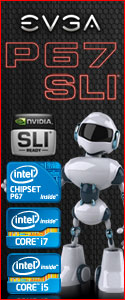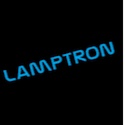Diamond Flower International, more commonly known as DFI, is based in Taipei Taiwan. They have been in the computing market for many years offering advanced motherboards, graphics solutions and applied computing platforms. When anyone thinks of DFI, the first thing that springs to mind is the word Lanparty.
This range of motherboards usually sports brilliant designs and one of the most efficient layouts that money can buy. While DFI is renowned for their Lanparty boards, they have always offered a lower cost alternative since the days of the 865 chipset. This company has also released lower cost versions which went under the infinity name. These had all of the features of their bigger brother Lanparty boards without the aesthetics or the hefty price tag.
The test board today comes from this range and is known as the DFI Bloodiron P45-2RS. This motherboard is being marketed in the budge range at a similar price to the Gigabyte EP45-DS3, so this should put it in the £90 region, which is excellent for a P45 board.

Specifications
DFI BLOOD-IRON P45 T2RS
| CPU | LGA775 socket for:- Intel core2 Quad and Intel Core 2 Duo
Supports Intel Enhanced Memory 64 Technology (EMT64T) Supports Enhanced Intel SpeedStep Technology (EIST) Supports Intel Hyper-Threading Technology Supports 1333/1066/800 MHz FSB
|
| Chipset |
Intel chipset – Northbridge: Intel P45 Expres chipset Intel Fast Memory Access technology Southbridge Intel ICH10R. |
| System Memory |
Four 240- pin DDR2 DIMM sockets Supports DDR2 667/800/1066MHz Delivers up to 12.8Gb/s bandwidth Supports dual channel (128-bit wide) memory interface Supports up to 8GB system memory Supports unbuffered x8 and x16 DIMMs |
| Expansion Slots |
2 PCI Express (Gen 2) x16 slots – 2 way Crossfire: One slot operating at x16 (16 lane port) or two slots each operating at x8 (8 lane ports) bandwidth
2 PCI Express x1 slots
2 PCI slots |
| BIOS | Award BIOS
8Mbit Spi flash BIOS CMOS Reloaded
|
| Audio | Realtek ALC885 High Definition audio CODEC
8 channel audio output
DAC SNR/ADC SNR of 106db/101db
full rate lossless content protection technology Optical S/PDIF out and coaxial RCA S/PDIF out interfaces |
| LAN | Realtek RTL8111C PCIE Gigabit LAN controller
Fully compliant to IEEE 802.3 (10BASE-T) 802.3u (100BASE-TX) and 802.3ab (1000BASE-T) standards |
| Serial ATA/Raid | Intel ICH10R chip
Intel Matrix Storage technology
Supports up to 6 SATA devices
SATA speeds up to 3Gb/s RAID 0, RAID 1, RAID 0+1 and RAID 5 |
| IDE | Jmicron JMB368 PCI Express to PATA host controller
Supports up to 2 UltraDMA 100Mbps IDE devices
|
| Rear Panel I/O | 1 mini-DIN-6 PS/2 mouse port
1 mini-DIN-6 PS/2 keyboard port
1 optical S/PDIF- out port
6 USB 2.0/1.1 ports
1 RJ45 LAN port
Center/subwoofer, rear R/L and side R/L jacks Line in, Line out (front R/L) and mic in jacks |
| Internal I/O | 3 connectors for 6 additional external USB 2.0 ports
1 connector for an external COM port 1 front audio connector 1 CD in connector 1 IrDa connector 6 Serial ATA connectors 1 40 pin IDE connector 1 floppy connector 1 24 pin ATX power connector 1 8 pin 12V power connector 1 front panel connector 4 fan connector 1 download flash BIOS connector |
| Power Management | ACPI and OS Directed Power Management
ACPI STR (suspend to RAM) function
Wake On PS/2 Keyboard/Mouse
Wake On USB Keyboard/Mouse
Wake On LAN
Wake On Ring
RTC timer to power on the system AC power failure recovery |
| Hardware Monitor | Monitors CPU/system/Northbridge temperature and overheat alarm
Monitors Vcore/Vdimm/Vnb/VCC5/12V/V5sb/Vbat voltages Monitors the speed of the cooling fans CPU Overheat Protection monitors CPU temperature and fan during system boot up- automatic shutdown upon system overheat |
| PCB |
4 Layers, ATX form factor 20.5cm (8.07â€ÂÂ) x 30.5cm(12â€ÂÂ) |
(www.dfi.com.tw accessed on 1/1/09)
WHATS IN THE BOX?
Upon viewing the Blood-Iron packaging, which sports a rather striking blood-embossing at the top of the box; it was found that the container had a look that was both striking and professional at the same time. After inspecting the box, the usual clutter was found inside including a user’s manual and a separate instruction leaflet explaining how to use the Auto Boost System. In addition, there are some very nice orange UV SATA cables in the box. However, the IDE and FDD cables are both of standard grey variety. The addition of orange IDE and FDD UV cables to match the SATA cables would have been nice, but this is certainly not the end of the world. Also included was a SATA raid floppy disk which many would feel is a very important addition. Many manufacturers put raid drivers on the driver CD, making is necessary for the user to make his own driver disk. Overall, with the box and contents, DFI has ticked all the boxes.
Click For a Larger Image
Click For a Larger Image
The layout of this motherboard is quite interesting due to the fact that DFI has chosen not to install heat sinks over the PWM modules. They must have decided the chips do not attain enough heat, even when overclocking, to warrant a heat sink. Next, the Northbridge heat sink is much the same as most motherboards of this type, as is the Southbridge. The CPU area looks rather cluttered with MOSFETS, so this would not make an ideal system board for using sub-zero cooling. However, the board is capable of accommodating any air or water cooling block. Lastly, the SATA ports though near the trailing edge of the board, are not of the 45 degree angle variety as is prevalent on many motherboards today. This allows air to flow unimpeded over the motherboard, however this innovation is sadly not present on this board.
BIOS
Click for a larger image
The familiar first screen of a Phoenix award bios.
Click for a larger image
Standard options in Advanced Chipset Features.
Click for larger image
Integrated Peripherals
Click for larger image
Our first look at the overclocking sections reveal a nice array of options.
Click for larger image
Plenty of options for memory timings, although
we have seen more on other boards.
Click for larger image
The voltage section also gives plenty of options to help
with overclocking your computer to the max.
Click for larger image
Cpu VID voltage increase is a massive 787.5mv, definitely
good for anyone on water cooling or phase.
Click for larger image
Plenty of memory divider options also.
When entering the BIOS it is obvious that, while this is a budget motherboard, DFI certainly did not hold back on the features. Once you enter the Genie BIOS setting section you will find all of the necessary options for your Overclocking needs. There are lots of different memory dividers, and options such as C1E are all kept neatly in the CPU feature section. Under voltage settings there are the following available ranges.
CPU VID Special add 0 – 787.5mv in 12.5mv increments
Dram Volts up to 3.280 volts
SB Core/CPU PLL Voltage 1.55v-2.15v in 0.20v increments
NB Core Voltage 1.1825- 1.9700v in .0025v increments
CPU GTL 0/2 0.67x-0.58x
CPU GTL 1/3 0.67x-0.58x
North Bridge GTL Ref Volt 0.67x-0.58x
Overclocking
Equipment Used To Test:
DFI Bloodiron P45 T2RS
Intel Core 2 Duo E7300 45nm 2.66ghz 10x Multi
Coolermaster Gemini II + 2x Antec 120mm Fans
2x2GB Patriot Viper series PC6400 4-4-4-12 2.1v
Ocz Powerstream 600w (UK Special Edition)
Leadtek Winfast 8800GT 512mb
Windows XP SP3
For the tests today, four speeds were chosen in order to show the performance. Initially the motherboard was tested with everything at stock speeds to get an idea of the overall performance
Stock Speed
E7300 @2.66ghz with memory at 800mhz, we ran 5 tests to compare against. In the first instance everest ultimate edition was installed and ran 4 benchmarks, these were the results:
Memory Read 6497MB/s
Memory Write 5655MB/s
Memory Latency 72.6ns
CPU Queen 11285
Super-pi 1M, which tests the CPU, completed in 19.859 seconds. This proved to be on a par with other P45 chipset motherboards. So, at stock speeds our budget motherboard matches much higher priced P45 boards for performance. Often times budget boards usually lack in performance compared to their higher priced compatriots, but as testing continued, we began to see the trimmed price cerrtainly did not compromised the performance.
3GHz
With Wolfdale CPU’s everybody now expects much higher clock speeds from their CPU. 3GHz was a very easy first target to hit. It was felt that this was an important speed to test as someone with little or no experience can get their CPU to this speed. To acheive 3ghz all that was needed was to increase the CPU VID special by 25mv, and drop the memory divider to 1:1. This was in preparation for later overclocks as it lowered the ram speed to 600Mhz. This memory speed however did not impact the overall performance. Once testing for stability was completed, the same tests that were ran at stock speeds were again run, and the results were:
Memory Read 5881 MB/s
Memory Write 6371 MB/s
Memory Latency 86.3ns
CPU Queen 12726
Super-Pi 1m 18.157 seconds
Noticeable would be the memory read bandwidth drops due to the RAM running at a much lower speed. The memory write speed increased because of the higher frequency of the CPU. Our Super-Pi time drops by 1.8 seconds with the CPU speed increase as well.
3.5GHz
The next target took a little more time to get as more work had to be done to achieve higher frequencies,
The settings we used to achieve a stable clock speed were.
CPU VID +175mv
SB core 1.75v
NB core 1.1900v
>Gtl ref 0.61x
NB Gtl 0.61x
This gave a solid stable base for the next round of tests.
Here is a screen shot at 3.5Ghz CPU-z is showing our voltage at 1.344v which is fine.
The results at this speed were:
Memory Read 6881 MB/s
Memory Write 7441 MB/s
Memory Latency 73.6ns
CPU Queen 14570
Super-Pi 15.501 seconds
As shown, the CPU is up to 3.5Ghz. The speed at which the memory reads and writes are substantially faster than at stock speed, which is superb as the memory is only running at 700mhz at this point . The Super-Pi time is down near the 15 second mark which is also good. At this frequency, there was a noticeable difference in speed, load times, and general response of the system.
3.7ghz
3.7Ghz was the final test speed on this motherboard. The settings used were,
CPU VID +225mv
SB core 1.75v
NB core 1.2200v
Gtl ref 0.61x
NB Gtl ref 0.61x
3.7ghz
As shown on CPU-z the voltage is now 1.392v which is perfectly acceptable for these CPU’s. At this speed our memory is now at 740mhz. The test results were,
Memory Read 7271 MB/s
Memory Write 7857MB/s
Memory Latency 70.0ns
CPU Queen 15694
Super-Pi 14.718 seconds
At 3.7ghz the system is flying along and having no difficulties whatsoever. Overclocking this motherboard was very simple throughout the whole process. As a whole, a very satisfying performance level was achieved.
The reason the overclocking was halted at 3.7Gz is due to the only fault that was found with this motherboard. When trying to go over 3.7ghz, the only way to get the system stable was to increase the Southbridge Voltage by one notch. This was were a problem was encountered. The issue was the stock voltage for the SB is 1.55v, it was running at 1.75v throughout our tests. The next step on the voltage range is 1.95v. The Southbridge heat would have become an issue when the voltage is set to 1.95v. Hopefully DFI will address this is in a later bios release. If the voltage could be increased to just 1.8v, then the system would become stable at much higher speeds.
Maximum FSB
Lowering the multiplier to x6 to see what the Front Side Bus can run at was postponed due to unforeseen circumstances. The usual test memory was off for repair during this test.
By lowering the Gtl ref to 0.58x it is likely that you will be able to produce similar or better overclocks with the use of less voltage. With some better memory there is no doubt about the potential of this motherboard to hit high FSB’s.
Summary
Throughout overclocking this Bloodiron motherboard there were no problems, it proved to be an exceptional budget motherboard for overclocking. All attempts to overclock this motherboard came easily, the only reason further testing was halted was due to limitations in the other components.
Pro’s
Excellent performance.
Good board layout.
Well packaged.
Overclocking potential.
Price
Cons
More Southbridge voltage options would be nice.
Grey strip IDE cables look out of place with the rest of the package
No post debug screen on the board
Conclusion
With the Dfi Bloodiron, the team at DFI have done a sensational job building and packaging an excellent budget motherboard. This motherboard does everything you would expect from a board twice the price, and does it with ease. While this motherboard does not look as nice as the Lanparty range, it certainly performs on a par with them. The only thing that was found was the lack of a post debug screen (which had been removed) but it should not be considered a deal breaker. As noted in the pro’s and cons , all the issues with this board are extremely minor.
Rating and Award
Gilgamesh Score of 91%
















 Posted in
Posted in 





